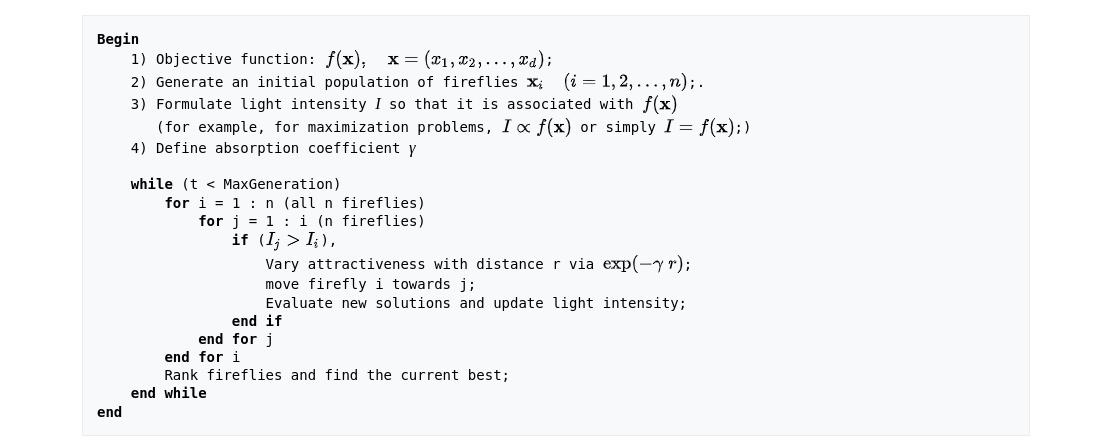Swarm Intelligence Series : Firefly/Glowbug Optimization Algorithm
 Akash Gss
Akash Gss
The firefly algorithm is a bio-inspired optimization method that draws its inspiration from the particular flashing pattern exhibited by fireflies. It was first developed by Xin-She Yang in 2008 and has been applied since then to a wide range of optimization problems, showcasing its versatility and effectiveness.
Introduction

The firefly algorithm also classified as a swarm intelligent, metaheuristic algorithm is inspired heavily by nature and it was developed in the year of 2008 through the process of observing the characteristic behaviors of the fireflies that are noticed. The population of fireflies tends to show characteristic flashing patterns as a means of communication, attracting a like-minded kin and risk warning from potential predators. It is very simple and easy to implement and is heavily based on the flashing patterns and behavior exhibited by tropical fireflies.
Inspiration
Imagine fireflies flying through a garden at night which is pitch black in nature, their tiny lights illuminating the green grass and flowers in the garden. These twinkling beacons possessed by them aren't just for show but they're part of a very sophisticated communication system. Fireflies use their light to attract mates and also mainly to signal danger and their flashing patterns can vary greatly among different species.
Scientists have taken inspiration from this natural phenomenon to develop a clever optimization algorithm called the firefly or glowworm optimization algorithm. This method, inspired by the social behavior and light emission characteristics of fireflies, is used to solve complex problems in various domains like engineering, computer science, and even finance.
Fireflies use bioluminescence to communicate and attract mates, it simulates this behavior to optimize solutions. The algorithm operates under the premise that all fireflies are unisex, meaning one firefly will be attracted to others regardless of their sex. The attractiveness of a firefly to another is proportional to the brightness of the fireflies, which in turn is determined by the landscape of the objective function. The less bright firefly will move towards the brighter one, and this attractiveness decreases as the distance between the fireflies increases. If there is no brighter firefly than a particular one, it will move randomly.
The movement of fireflies in this algorithm is guided by their attractiveness towards brighter solutions, with the distance between fireflies playing a crucial role in determining the strength of this attraction. As the distance increases, so does the decrease in attractiveness, mirroring the real-world phenomenon where the signal's strength diminishes with distance. This biologically inspired mechanism allows the FA to balance exploration and exploitation, ensuring a thorough search of the solution space while also converging toward high-quality solutions.
The algorithm's approach to optimization is not only innovative but also highly effective. It has found wide application across various domains, including function optimization, robotics, and signal processing. By replicating the natural communication and mating behaviors of fireflies, the algorithm offers a bio-inspired solution to complex optimization problems, demonstrating the immense potential of biological systems in informing computational algorithms.
Convergence
The convergence aspect of the firefly algorithm is a critical aspect that determines how well the algorithm can find an optimal or a near-optimal solution to a given problem within a reasonable number of iterations. Convergence refers to the point at which the algorithm tends to stabilize meaning the solution quality has reached its optimum point and does not undergo any more paradigm shifts in its value. This algorithm in general is known for its ability to efficiently explore the search space, thanks to its attractiveness mechanism, which encourages fireflies to move towards much brighter solutions. However, the algorithm's performance in terms of convergence can vary widely depending on the problem instance and the specific implementation of the way the algorithm has been utilized to solve the problem at hand. This algorithm in general tends to converge towards an optimum solution in a relatively short amount of time making it suitable to solve optimization problems that have computational constraints.
Algorithm of the Firefly Optimization Algorithm

Initialization: The algorithm starts with the initialization of a population of fireflies with random positions in the search space. Each firefly represents a potential solution to the problem to be solved.
Fitness Evaluation: The fitness of each firefly is based on the objective function of the problem, the fitness represents how good of a solution the firefly algorithm represents.
Attractiveness and Brightness: The attractiveness of a firefly to another is determined by its brightness, which in turn is influenced by the value of the objective function at that position. The brightness of a firefly is proportional to the value of the objective function at its position. If a firefly is less bright, it will be more attracted to the brighter fireflies. This attractiveness tends to decrease as the distance between these fireflies increases and the brightness also obviously decreases because of this.
Movement: The Fireflies tend to move toward brighter solutions based on their attractiveness. The movement is influenced by the attractiveness towards other fireflies and a randomization parameter. If there is no brighter firefly, the firefly moves in a random fashion. The movement can be calculated using a distance-based formula, considering the attractiveness and randomization parameters.
Light Intensity Update: After each movement, the light intensity of each firefly is updated based on its fitness value. This update reflects the firefly's new position in the search space.
Termination: This algorithm repeats the movement and updates the light intensity steps until a termination criterion is met, such as a maximum number of iterations or a satisfactory level of fitness.
Extraction: After termination, the best solution found by the algorithm is extracted. This is typically the firefly with the highest brightness, representing the optimal solution to the optimization problem.
Search Parameters of the FireFly Optimization Algorithm
The Firefly algorithm has several key parameters that can influence the performance and behavior of the algorithm as a whole. These parameters are crucial for tuning the algorithm to the specific optimization problem at hand. The key parameters used are :
Population Size: This parameter determines the number of fireflies in the swarm. A larger population size can increase the diversity of solutions explored, but it also increases the computational cost.
Attractiveness Coefficient: This coefficient controls the strength of the attraction between fireflies. It influences how quickly fireflies are drawn toward better solutions. A higher attractiveness coefficient means fireflies are more likely to move towards brighter fireflies, potentially leading to a faster convergence but also increasing the risk of premature convergence.
Randomization Parameter: This parameter introduces randomness into the movement of fireflies. t helps in exploring the search space more effectively by preventing the algorithm from being stuck in a local optima. The randomization parameter is typically a small value such as 0.01 to ensure that the algorithm explores the search space thoroughly without staying too far from the optimal solution.
Brightness Threshold: This parameter sets the minimum brightness value below which a firefly will not be considered for attracting other fireflies. It helps in controlling the exploration versus exploitation trade-off by ensuring that only the most promising solutions (those with high brightness) are considered for attracting other fireflies.
Distance Threshold: This parameter determines the maximum distance between two fireflies for them to be considered attractive to each other. It helps in controlling the spread of the fireflies in the search space, ensuring that the algorithm remains focused on exploring the most promising areas of the search space.
Light Absorption Coefficient: This coefficient models the decrease in brightness of a firefly as it moves away from the source of light (the brighter fireflies). It simulates the physical phenomenon of light absorption, which affects the attractiveness of fireflies based on their distance from the brighter solutions.
Variations in the Firefly Optimization Algorithm
The firefly algorithm has been widely studied and applied in various domains leading to numerous variations and adaptations to improve its performance, applicability, and convergence behaviour. Here are some of the notable variations of the algorithm -
Dynamic Firefly Algorithm: This algorithm is an extension of the algorithm that aims to improve the algorithm's convergence and performance by dynamically adjusting its parameters like the adaptive attractiveness coefficient, dynamic population size, and the dynamic brightness threshold based on the search progress.
Improved Firefly Algorithm: This algorithm introduces several enhancements to the original like the introduction of a fitness-based attraction mechanism where the fireflies are attracted to solutions with better fitness values enhancing the algorithm's ability to search towards better solutions and avoiding premature optimizations or stopping. And, the algorithm also enhances the process of search exploration with a much better-sophisticated search exploration strategy like the use of chaotic maps and so much more.
Adaptive Firefly Algorithm: This algorithm focuses on adapting the algorithm's parameters based on the search progress so far to improve convergence. The parameters like the light absorption coefficient and the adaptive distance threshold are dynamically adjusted in the case of this algorithm to reflect the current search state space and to maintain a balance between exploration and exploitation respectively.
Multi-Objective Firefly Algorithm: This approach uses the Parent Front approach to maintain a set of solutions that represent the Pareto Front and to balance trade-offs between conflicting objectives. The fitness function used in this algorithm is adapted to handle multiple objectives often using methods like the weighted sum approach or the non-dominated sorting genetic algorithm and it also uses solution ranking where the solutions are ranked and sorted based on their performance on multiple objectives with the algorithm focused on improving the overall quality of the solutions rather than focusing on individual objectives or goals.
Parallel Firefly Algorithm: This algorithm is used to reduce the load on the computational resources and to speed up the search process and this algorithm updates the positions and light intensities of the fireflies in parallel, taking advantage of multiple processors or cores. The exploration and exploitation processes are carried out in parallel, with different fireflies or subsets of the population exploring different areas of the search space in a much more efficient manner and can also detect convergence more quickly by comparing the solutions of different subsets of the population in parallel.
Applications of the Firefly Algorithm
Reducing Production Costs in Manufacturing: The firefly optimization algorithm can be used to optimize and reduce the amount of time taken for production in factories through the process of optimizing the production schedules while meeting demand.
Designing a lightweight and strong bridge: This algorithm can be used to optimize the design of a bridge to minimize its weight while maintaining its structural integrity.
Classification of Medical Imagery: It can be used to develop algorithms that accurately classify medical images such as X-rays and MRI Scans.
Fixing Routing Problems in Networks: This algorithm is heavily utilized for finding optimal routes for vehicles or data packages in networks, reducing travel time and congestion in the network thereby improving its overall speed and reliability.
Limitations
Parameter Sensitivity: The algorithm's performance is highly sensitive to the choice of parameters used like the attractiveness coefficient, the randomization parameter, and the distance threshold. If in any case, these parameters have not been optimally tuned, a premature convergence may occur where the algorithm tends to find a local optimum instead of solving for a global one, and in some cases, it may not converge at all. This sensitivity makes the algorithm less robust and requires careful tuning for different optimization problems.
Difficulty in Handling Non-continuous Variables: Although the algorithm was initially designed for continuous optimization problems, its effectiveness has led to its modifications for solving non-continuous problems, like binary and integer-valued problems. These modifications, however, introduce additional complexity and require careful consideration of the feasible region aka the search space, and the distance between the individual fireflies or "solutions" which can be challenging to implement in practice.
Computational Expense for High-Dimensional Problems: This algorithm can become computationally very expensive in particularly high-dimensional optimization problems. This is because of the algorithm's tendency to increase in complexity as the number of dimensions increases, making it less suitable for problems with a large number of variables. While some modified versions of this algorithm have been developed to address this issue, the increased computational demands remain a significant limitation.
Convergence Rate: The convergence rate of this algorithm can be slow, especially for complex optimization problems with many local optima. This slow convergence rate is a common challenge for many swarm intelligence algorithms, including the FA. While modifications have been proposed to improve the convergence rate, achieving fast and reliable convergence remains a challenging aspect of the algorithm
Lack of a Guaranteed Convergence: This algorithm does not guarantee convergence to the globally optimum solution for all optimization problems. The algorithm can struggle to converge to the expected global optimum solution for highly non-linear and computationally complex optimization problems and the users of it need to do a careful amount of planning and fine-tuning to make it work well for their use case.
Noise Sensitivity: The performance of the algorithm can be implemented by any noise in the objective function potentially leading to inaccurate solutions.
Limited amount of Knowledge Sharing: As compared to other swarm intelligence algorithms, this algorithm's information exchange between its fellow solutions might be less efficient impacting the overall knowledge transfer and convergence speed.
Code Implementation with MealPy
The Firefly Optimization Algorithm can be implemented with the help of the MealPy Library as follows in Python.
import numpy as np
from mealpy import FloatVar, FFA
def objective_function(solution):
return np.sum(solution**2)
problem_dict = {
"bounds": FloatVar(lb=(-10.,) * 30, ub=(10.,) * 30, name="delta"),
"minmax": "min",
"obj_func": objective_function
}
model = FFA.OriginalFFA(epoch=100, pop_size=50, gamma = 0.001, beta_base = 2, alpha = 0.2, alpha_damp = 0.99, delta = 0.05, exponent = 2)
g_best = model.solve(problem_dict)
print(f"Solution: {g_best.solution}, Fitness: {g_best.target.fitness}")
print(f"Solution: {model.g_best.solution}, Fitness: {model.g_best.target.fitness}")
Conclusion
In conclusion, the Firefly Algorithm, inspired by the natural behavior of fireflies, offers a bio-inspired approach to solving complex optimization problems. Its ability to mimic the natural communication and mating behaviors of fireflies provides an efficient and flexible method for addressing a wide array of optimization challenges.
And, while the Firefly Algorithm offers a powerful and flexible approach to optimization problems, its limitations highlight the need for careful parameter tuning, consideration of problem characteristics, and the development of modifications to improve its performance on specific types of problems. Researchers continue to explore ways to enhance the algorithm's capabilities and address its limitations, contributing to its ongoing evolution and applicability across various domains.
Subscribe to my newsletter
Read articles from Akash Gss directly inside your inbox. Subscribe to the newsletter, and don't miss out.
Written by
